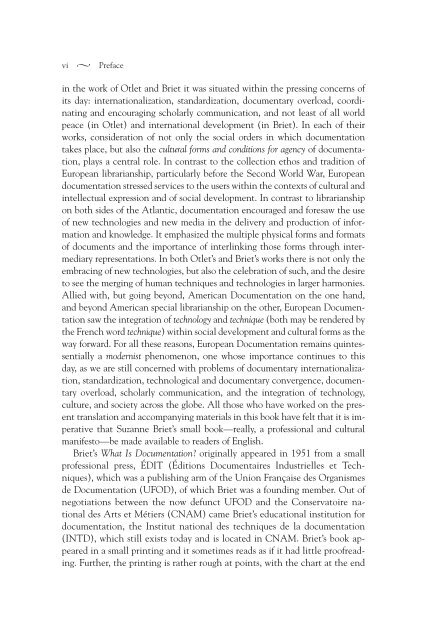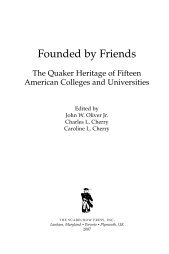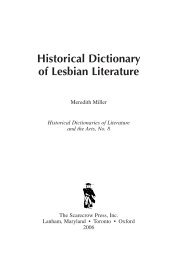What Is Documentation? - Scarecrow Press
What Is Documentation? - Scarecrow Press
What Is Documentation? - Scarecrow Press
You also want an ePaper? Increase the reach of your titles
YUMPU automatically turns print PDFs into web optimized ePapers that Google loves.
vi Preface<br />
in the work of Otlet and Briet it was situated within the pressing concerns of<br />
its day: internationalization, standardization, documentary overload, coordinating<br />
and encouraging scholarly communication, and not least of all world<br />
peace (in Otlet) and international development (in Briet). In each of their<br />
works, consideration of not only the social orders in which documentation<br />
takes place, but also the cultural forms and conditions for agency of documentation,<br />
plays a central role. In contrast to the collection ethos and tradition of<br />
European librarianship, particularly before the Second World War, European<br />
documentation stressed services to the users within the contexts of cultural and<br />
intellectual expression and of social development. In contrast to librarianship<br />
on both sides of the Atlantic, documentation encouraged and foresaw the use<br />
of new technologies and new media in the delivery and production of information<br />
and knowledge. It emphasized the multiple physical forms and formats<br />
of documents and the importance of interlinking those forms through intermediary<br />
representations. In both Otlet’s and Briet’s works there is not only the<br />
embracing of new technologies, but also the celebration of such, and the desire<br />
to see the merging of human techniques and technologies in larger harmonies.<br />
Allied with, but going beyond, American <strong>Documentation</strong> on the one hand,<br />
and beyond American special librarianship on the other, European <strong>Documentation</strong><br />
saw the integration of technology and technique (both may be rendered by<br />
the French word technique) within social development and cultural forms as the<br />
way forward. For all these reasons, European <strong>Documentation</strong> remains quintessentially<br />
a modernist phenomenon, one whose importance continues to this<br />
day, as we are still concerned with problems of documentary internationalization,<br />
standardization, technological and documentary convergence, documentary<br />
overload, scholarly communication, and the integration of technology,<br />
culture, and society across the globe. All those who have worked on the present<br />
translation and accompanying materials in this book have felt that it is imperative<br />
that Suzanne Briet’s small book—really, a professional and cultural<br />
manifesto—be made available to readers of English.<br />
Briet’s <strong>What</strong> <strong>Is</strong> <strong>Documentation</strong>? originally appeared in 1951 from a small<br />
professional press, ÉDIT (Éditions Documentaires Industrielles et Techniques),<br />
which was a publishing arm of the Union Française des Organismes<br />
de <strong>Documentation</strong> (UFOD), of which Briet was a founding member. Out of<br />
negotiations between the now defunct UFOD and the Conservatoire national<br />
des Arts et Métiers (CNAM) came Briet’s educational institution for<br />
documentation, the Institut national des techniques de la documentation<br />
(INTD), which still exists today and is located in CNAM. Briet’s book appeared<br />
in a small printing and it sometimes reads as if it had little proofreading.<br />
Further, the printing is rather rough at points, with the chart at the end
















